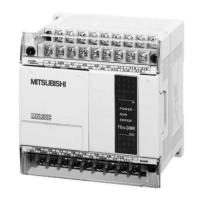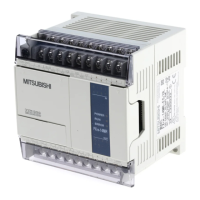FX Series Programmable Controllers Points Of Technique 10
10-25
10.15.3 Using the PID alarm signals
Included as part of the data block there are four alarm values. These set the maximum positive
and negative change that should occur to MV and PV. The PID alarm signals are used to warn
of the system going out of control.
When the system is starting from cold it is usually not good to include the Derivative numbers
of the in the calculation; the changes to PV are large and the Derivative introduces too much
correction. Also, if the system starts to move rapidly away from the SV then sometimes the use
of D can over correct and cause chasing.
By having an 'alarm' flag for the change in PV and MV it is possible to monitor the state of the
system and adjust the PID parameters to appropriate settings.
When the system is close to the SP the changes in PV (and MV) should be minimal.
In this situation using full PID is very useful in keeping the system close to the SP. (Full PID is
appropriate).
However, if the conditions change (e.g. opening a refrigerator door, adding ingredients to a
mixture, cold start, etc.) the system reacts. In some cases (especially cold start) the reaction is
too much for the D to be useful (PI or sometimes just P only is better). In these cases the alarm
flags can be used to change to PI control until the system returns to a more stable condition,
when full PID can then be used.
Basically, rather than use actual values of the PV to determine the change over point from PI to
PID (or PID to PI), use the size of the change in PV (or MV). This means changes to the Set
Point do not require different ranges for the PI - PID change over point (at least, in theory).
10.15.4 Other tips for PID programming
• It is recommended that an input value for PV is read before the PID is activated. Otherwise,
the PID will see a big change from 0 to the first value and calculate as if a big error is
occurring.
• The PID instruction is not interrupt processed. It is scan dependent and as such the
sampling can not occur faster the FX scan time. It is recommended that T
S
is set to a
multiple of the program scan time.
• To keep timing errors to a minimum it is recommended that constant scan is used.
• To improve sampling rates it is possible to put the PID instruction inside a timer interrupt
routine.
• It is better to have the PID only perform P until the input value (PV) reaches the working
range.
• When setting up it is a good idea to monitor the input and output of the PID instruction and
check that they are about the expected values.
• If the PID system is not operating properly check the error flags for PID errors (D8067).
